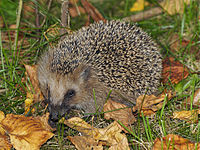
Photo from wikipedia
Fertility and hatchability are economically important traits due to their effect on poult output coming from the turkey hatchery. Traditionally, fertility is recorded as the number of fertile eggs set… Click to show full abstract
Fertility and hatchability are economically important traits due to their effect on poult output coming from the turkey hatchery. Traditionally, fertility is recorded as the number of fertile eggs set in the incubator (FERT), defined at a time point during incubation by the identification of a developing embryo. Hatchability is recorded as either the number of fertile eggs that hatched (hatch of fertile, HOF) or the number hatched from all the eggs set (hatch of set, HOS). These traits are collected throughout the productive life of the bird and are conventionally cumulated, resulting in each bird having a single record per trait. Genetic evaluations of these traits have been estimated using pedigree relationships. However, the longitudinal nature of the traits and the availability of genomic information have renewed interest in using random regression (RR) to capture the differences in repeatedly recorded traits, as well as in the incorporation of genomic relationships. Therefore, the objectives of this study were: 1) to compare the applicability of a RR model with a cumulative model (CUM) using both pedigree and genomic information for genetic evaluation of FERT, HOF, and HOS and 2) to estimate and compare predictability from the models. For this study, a total of 63,935 biweekly FERT, HOF, and HOS records from 7,211 hens mated to 1,524 toms were available for a maternal turkey line. In total, 4,832 animals had genotypic records, and pedigree information on 11,191 animals was available. Estimated heritability from the CUM model using pedigree information was 0.11 ± 0.02, 0.24 ± 0.02, and 0.24 ± 0.02 for FERT, HOF, and HOS, respectively. With random regression using pedigree relationships, heritability estimates were in the range of 0.04–0.09, 0.11–0.17, and 0.09–0.18 for FERT, HOF, and HOS, respectively. The incorporation of genomic information increased the heritability by an average of 28 and 23% for CUM and RR models, respectively. In addition, the incorporation of genomic information caused predictability to increase by approximately 11 and 7% for HOF and HOS, respectively; however, a decrease in predictability of about 12% was observed for FERT. Our findings suggest that RR models using pedigree and genomic relationships simultaneously will achieve a higher predictability than the traditional CUM model.
Journal Title: Frontiers in Genetics
Year Published: 2022
Link to full text (if available)
Share on Social Media: Sign Up to like & get
recommendations!